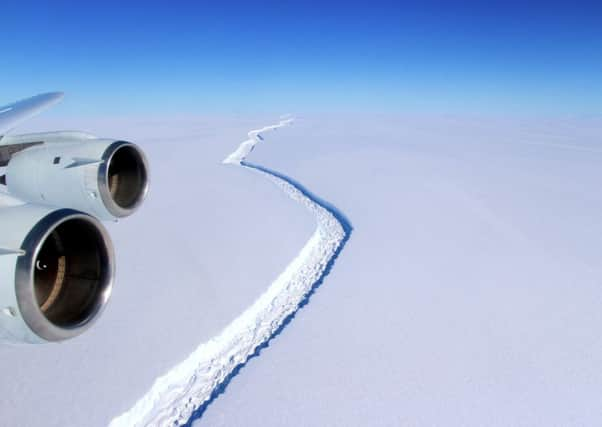Vast iceberg '˜hanging by thread' will break off from Antarctic


The Larsen C Ice Shelf is expected to lose an area of more than 1,900 square miles after a rift in the ice shelf grew suddenly by around 11 miles in the second half of December.
A mere 12 miles of ice now connects the iceberg to the rest of the shelf, according to researchers from the Midas project, which has been studying the stability of the Larsen C Ice Shelf for three years.
Advertisement
Hide AdAdvertisement
Hide AdThe project’s lead researcher, Professor Adrian Luckman from Swansea University, said the iceberg – one of the largest ever recorded – was now “hanging by a thread.”
When it eventually calves off, the Larsen C Ice Shelf will lose more than 10 per cent of its area, fundamentally changing the landscape of the Antarctic peninsula, and rendering the remaining shelf less stable, the experts said.
The current event is not an ice shelf collapsing, but Larsen C may, in years or decades to come, follow the course of the Larsen B Ice Shelf which splintered and collapsed in the space of a month in 2002, they said.
Ice shelves hold back the ice on the land, and their collapse can allow glaciers behind them to discharge into the sea quicker – with a potential impact on sea levels.
Mr Luckman said that while warming temperatures in the Antarctic will not have helped the stability of the ice, the growth in the fissure was not “directly” associated with climate change.
He explained: “This is a rift that is decades old, it is more likely that we can put this down to a natural development of the rift.
“In the 1990s, Antarctica was one of the fastest warming places on Earth. It has started to cool down a little bit but long term this is a warming place.
“That can’t have helped, I’m sure that’s part of the explanation of wider ice shelves collapsing. But we can’t directly attribute this to climate change.”
Advertisement
Hide AdAdvertisement
Hide AdIn June the crack grew 12 miles in a short space of time, before the latest growth in the rift in December.While the calving of the iceberg is “inevitable”, the researchers could not say exactly when it will happen – though it could be months before it goes.
“It’s not predictable, it very much depends on the local weather conditions. These events are basically chaotic and unpredictable,” Mr Luckman added. ““We are convinced, although others are not, that the remaining ice shelf will be less stable than the present one.”